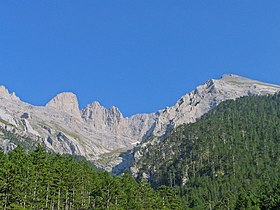Mount Olympus, Greece
| Mount Olympus | |
|---|---|

Mount Olympus
|
|
| Highest point | |
| Elevation | 2,917 m (9,570 ft) |
| Prominence | 2,355 m (7,726 ft) |
| Isolation | 254 kilometres (158 mi) |
| Listing |
Country high point Ultra |
| Coordinates | 40°05′08″N 22°21′31″E / 40.08556°N 22.35861°ECoordinates: 40°05′08″N 22°21′31″E / 40.08556°N 22.35861°E |
| Geography | |
| Location | Greece |
| Parent range | Macedonia and Thessaly, near the Gulf of Salonika |
| Climbing | |
| First ascent | 2 August 1913 Christos Kakalos, Frederic Boissonnas and Daniel Baud-Bovy |
Mount Olympus (/oʊˈlɪmpəs, ə-/;Greek: Όλυμπος [ˈolimbos] or [ˈolibos]; also transliterated as Olympos, and on Greek maps, Oros Olympos) is the highest mountain in Greece. It is located in the Olympus Range on the border between Thessaly and Macedonia, between the regional units of Pieria and Larissa, about 80 km (50 mi) southwest from Thessaloniki. Mount Olympus has 52 peaks, deep gorges, and exceptional biodiversity. The highest peak, Mytikas, meaning "nose", rises to 2,917 metres (9,570 ft). It is one of the highest peaks in Europe in terms of topographic prominence.
Olympus was notable in Greek mythology as the home of the Greek gods, on the Mytikas peak. Mount Olympus is also noted for its very rich flora, with several species. It has been a National Park, the first in Greece, since 1938. It is also a World's Biosphere Reserve.
...
Wikipedia

